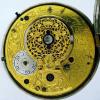Electroplating At Home
-
Recently Browsing
- No registered users viewing this page.
-
Topics
-
Posts
-
By Neverenoughwatches · Posted
Depends what sizes of watches you mostly service . If you were to say pocket watches then you might benefit by wholly replacing the 9010 for 9020. As a rough guide hp500 is twice the viscosity of 9020 which is twice the viscosity of 9010 at 20°c. So hp500 would give you a more mid-range oil between thin 9010 and HP1300, but as it happens hp750 is more mid- range than hp500, but is that more or less useful when oiling a train of wheels. After the barrel arbor the jump down in pivot size is around half, then after the centre wheel maybe more than half until the escapement. And pivot size isn't especially a deciding factor, as the torque and speed of a pivot would be more relevant when thinking about which oil to choose. So 750 might only be useful on a centre wheel and nothing else, and 500 might be better than 1300 for oiling the centre wheel but still comprises the rest of the train, where 9020 would be ok for the train but too thin for the centre wheel, leaving only 1300 for the oiling of it. You see the problem we're having here. What can be ok for one thing is less ok for another in a different way, damping down power compared to oil spread. Maybe mixing a drop from two opposite range viscosity synthetic oils will give you some approximate thickness oil in-between . You want a short answer now, I tnink I'd go with the 9020. Now be prepared for a whole host of different answers. -
So, working on watches and your karma at the same time: win-win situation!
-
@SteveF , Go on to Dr ranfft website, Enter keywords Omega 26.5T3 ranfft . There Dr ranfft has listed all related calibers to this family, all which beat the same frequency, any balance complete of this family fit your watch. This would only expenad your choice of balance complete. Recolleting your hairspring is easy, but matching it with a balance of the family is challanging. Regs
-
By nevenbekriev · Posted
Yes, it looks much better, but at this point the main thing is to make the spring in one plain. so picture from side will show this better. Now it is seen that #1 bending is needed, which is normal.
-









Recommended Posts
Join the conversation
You can post now and register later. If you have an account, sign in now to post with your account.
Note: Your post will require moderator approval before it will be visible.